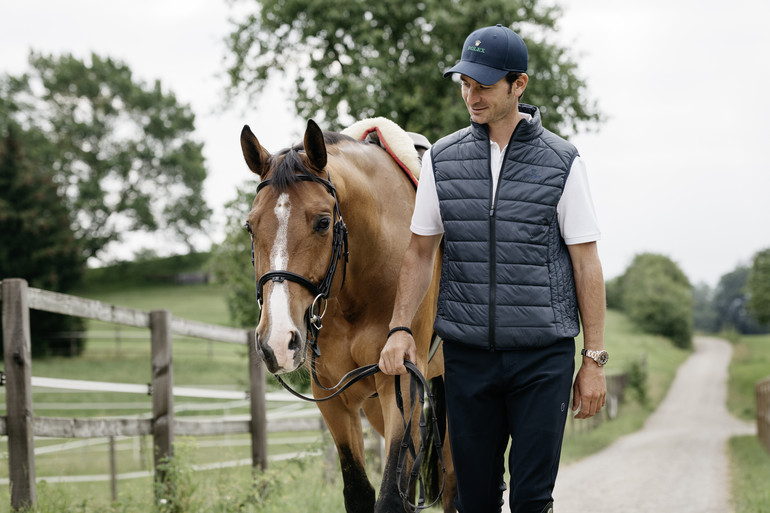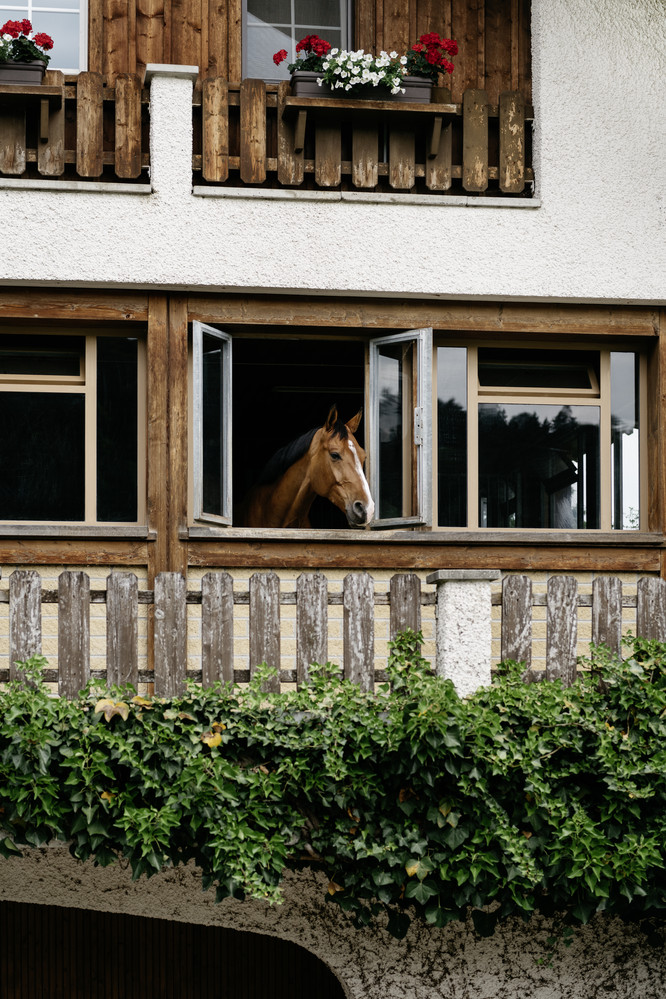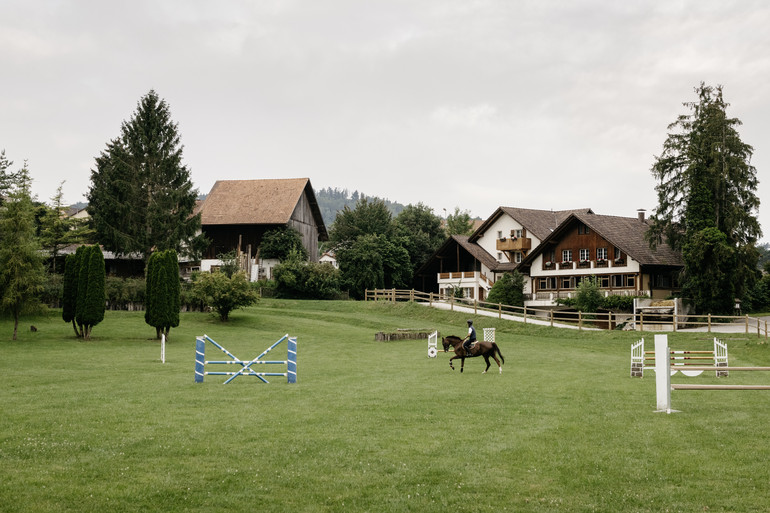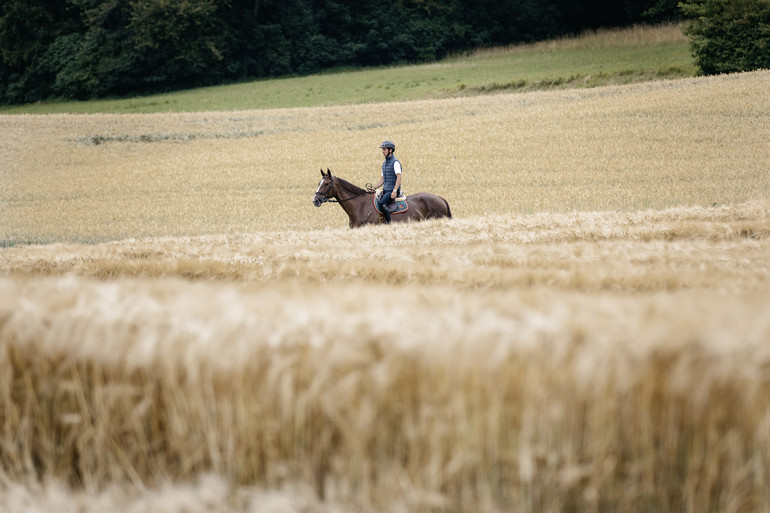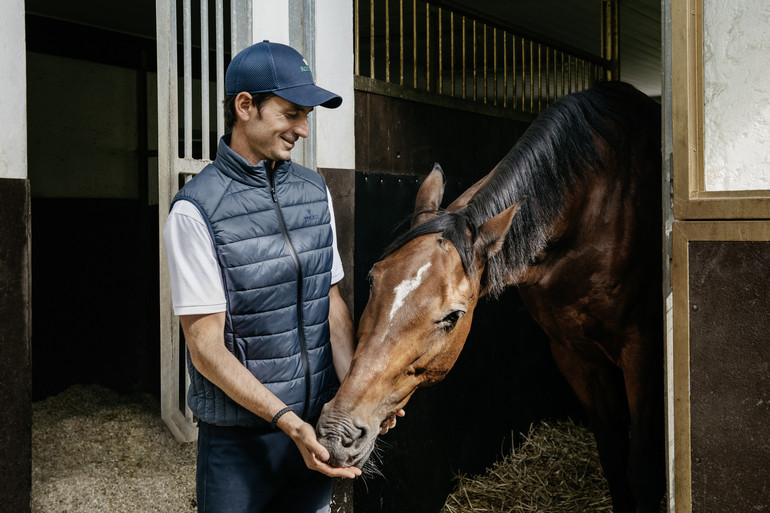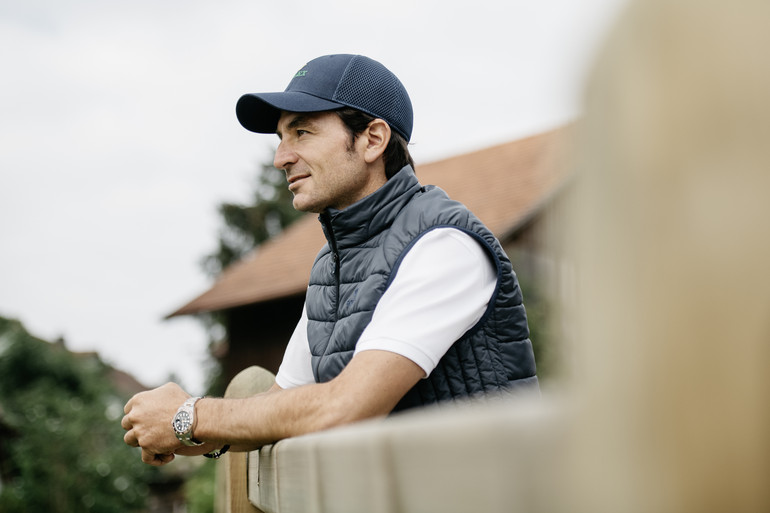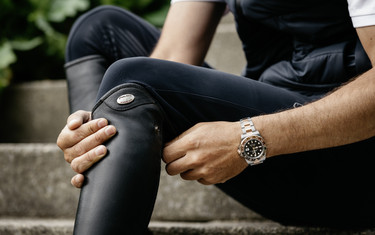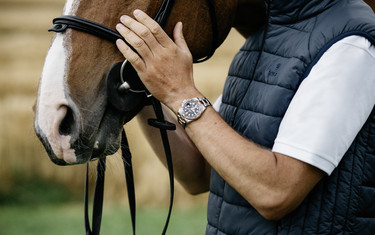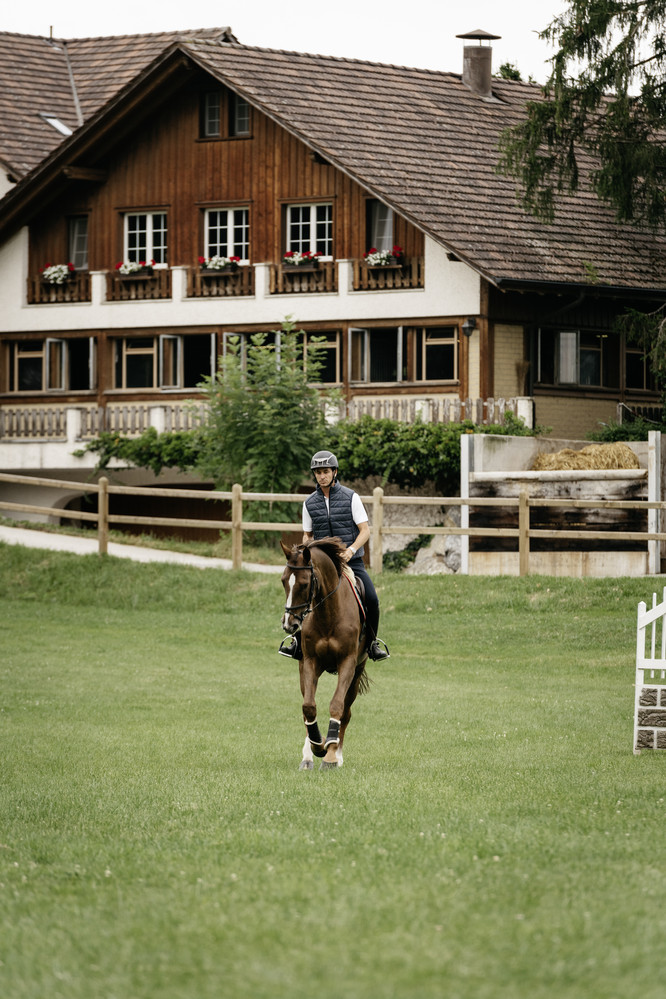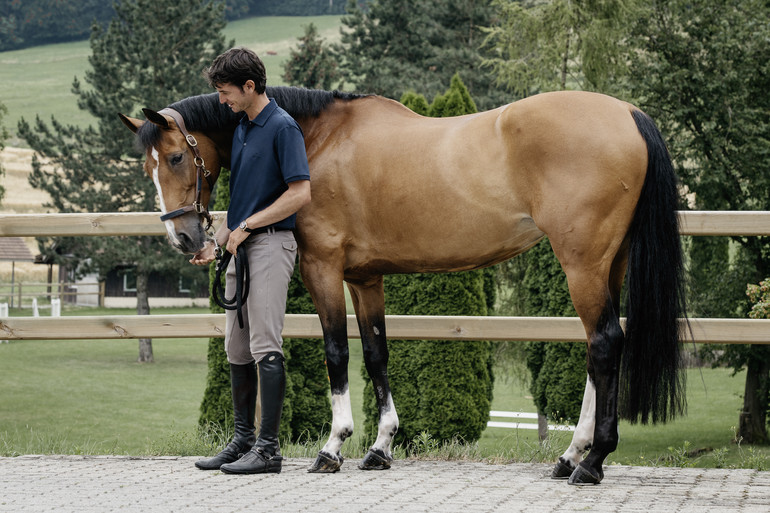Text © World of Showjumping
Olympic Champion, triple World Cup Champion, European Team Champion and world no. one for the last nine consecutive months – Steve Guerdat needs no additional introduction, his name speaks for itself. The 37-year-old Swiss rider is one of the most respected on the showjumping circuit, a horseman through and through – and all about his sport.
Thanks to an invitation from Rolex, World of Showjumping got to spend a day with Guerdat at his beautiful stables in Elgg, Switzerland.
Guerdat has found his paradise in an idyllic countryside setting, a little less than an hour’s drive from Zurich. Surrounded by green fields and hills, the only sounds you will hear here is bird-song and cow-bells – and of course the clatter of hooves. The backdrop is as Swiss as it gets. Adding to the scenery is Guerdat’s stable, which looks like a chalet – with his world-famous horses sticking their heads out from their 1stfloor boxes that have a view of the sprawling grounds and beyond. When Guerdat bought the stables and moved in 1st of February 2017, he fittingly followed in former owner Paul Weier’s footsteps – also a famous Swiss Olympian – who drew people from all over the world to his stables in Elgg. Today, the charming forty-year-old equestrian centre is home to Guerdat and his horses.
While Guerdat is known for being outspoken, especially when it comes to political aspects of the sport that he loves, he is however not a big talker. Quiet, at times pending towards shy, Guerdat is not one to seek media’s attention. Still, the media loves him – for our visit writers from all over the world has flown in, coming all the way from exotic locations such as India and Mexico to meet the Swiss showjumper.
If he could choose, Guerdat would probably prefer to talk with his horses rather than the media on this beautiful sunny day. Because, that is – he explains – more or less what he does when he is riding them every day. “It’s difficult to explain what riding is,” Guerdat says. “It’s something I believe I feel – not something I do. As a rider, I develop a relationship with my horses and with time I get to know them. It’s like a relationship with a friend, you don’t have to ask, ‘How are you?’ – you will see it straight away on their expression,” he smiles.
When working his horses, Guerdat draws parallels to having a dialogue with them. “I ask questions, they answer them,” he says. “And every horse has its own personality, so as a rider I have to adjust.”
It’s not only when he rides, that Guerdat is listening to his horses. They also have their say when he plans his extremely busy show schedule. “Of course, it is important to pick the right horses for the right venue, but you also have to consider the form of the moment,” he tells. “The horses will tell you if they want to go, if they want to compete or if they need a break. I think it is important to have a big enough string of horses, so you can take the horse that feels the best at that moment even though it might not have been the original plan. Having several top horses makes it possible to change and adapt, and also to keep all the horses happy and healthy.”
Happy and healthy seem to be two key-words in Guerdat’s horse management. “My main line is always that a horse is a horse, it is an animal, and an animal comes from the nature and belongs in the nature,” the Olympic Champion says. “Here, my horses go in the field every day from April to October. During winter, they go out in the paddocks when it’s snow. I prefer to ride them in the big grass field, I don’t ride much in the sand ring. Actually, I don’t know when I rode here last time,” he laughs. “We have lots of natural jumps, and we use all of them – the horses really like it! At home, we rarely jump over 1.30m. When I’m here, it’s about relaxing and doing things that the horses learn from.”
Guerdat also prefers to keep it low-key in the stables. “My horses have a very basic diet, simple and natural. That they have good hay, that is the most important. I try to avoid too much hard feed, and rather give them hay five-six times a day so they always have something to chew on. I also prefer keeping them on straw, then they have something to eat on the whole day and avoid getting bored.”
“Is this mainstream? I don’t know. I’m not really looking to what others do – of course I try to learn from others to improve – but I want to go in the direction I believe is right for me and my horses,” Guerdat says when asked if this kind of horse management is normal at the highest level of the sport. “For sure, the majority of the riders do what they believe is the best for their horses. I do believe though, that sometimes people end up overdoing what they think is best – even though it’s well-meant. They want horses to be looked after as if they are gold, to protect them too much to avoid injuries – and I don’t believe that is the best way. There are for sure people spending all their time brushing and polishing their horses, using expensive massage equipment, bandaging all day every day – spending lots and lots of money on treatments and therapies. In my opinion, you make the horses too soft like this. The horses should go in the field and be horses – get hardy and tough. There is no logic to not turning the horses in the field because you are scared they will get injured, but at the same time expect it to stay sound jumping a 1.60m class as fast as it gets,” he says.
Although a firm believer in horses being horses, Guerdat is also of the opinion that his four-legged friends know very well that they are athletes and that they like competing. “On Sundays, when the crowd is there at the big shows – the horses transform,” he says. “They want to show off, show how good they are. What makes our sport unique then, in that moment, is that it’s about coming together and be one. Trying to achieve a 100 % together.”
Win or lose, Guerdat is all about giving his horses the same treatment. “If we win, or if we have a very bad round, my horses will always get the same attention. Because the horse did not ask to jump that class that day. I made the horse do that,” he says. “The horses are not asking to be here with us, so the least we can do is to give them the best possible care whatever the situation. If I have a bad round, I tend to get very upset with myself and very upset with people around me – but I never take my frustration out on my horse.”
Being patient with his horses, was something Guerdat was taught at an early age. His father Philippe Guerdat, today a world-famous coach and trainer, and his mother Christiane put their two sons on a pony before they could walk. “When I was 10, I started doing the shows,” Guerdat tells. “I never had a competition pony, my father wanted us to ride horses – back then pony sport was kind of like sitting on and going as fast as you could to win. That was not what my dad wanted for us, he wanted us to learn how to ride and preferred us to focus on that rather than winning. My first 7-8 shows were not very successful, I think I was eliminated every time. My mum went with me to the shows and got increasingly frustrated by getting up at 6 AM, driving around the steep Swiss countryside only to see me being unable to finish the courses. My mum begged my dad for a new horse that would take me around, but he would not give in until I had completed at least one course with that horse. When I finally managed to complete three-four courses, he gave me a better one to ride,” Guerdat smiles.
Patience is also key for Guerdat when producing his horses, and his philosophy is to never rush the good things – they will come eventually. “It’s easy to think that you can gain something at the beginning of the horses’ careers when they are 8, 9, 10, but I actually think that the more you push too early the more you lose in the other end. If you only start asking for more around the time the horses have turned 10, you end up prolonging their careers,” he says.
One that lasted long for Steve is his Olympic Champion Nino des Buissonnets. After having been retired in a tearful ceremony at CHI Geneva back in 2016 – where the pair won the Rolex Grand Prix twice – Nino now lives a happy and peaceful life in the fields in Elgg. “He has an open stable where he walks in and out as he wants. Four-five times a week a local girl comes to hack him out. He’s just enjoying life,” Steve smiles as we pay his former super-star a visit.
Guerdat’s illustrious career is full of highlights, many of them have come on home soil at CHI Geneva. “The first time I won the Rolex Grand Prix in Geneva was in 2006,” he tells. “I had no idea how much prize money I won, but I won my first Rolex and that was way more important to me. I gave the watch to my groom Heidi Mulari. Then next Rolex I won, I gave to my mum.”
Guerdat has been a part of the Rolex family since 2012. “It is very nice to be supported by Rolex, a brand that is already so committed to the sport. The fact that there already is an existing relationship between Rolex and equestrian sports means a lot to me, it’s a bigger picture,” he says.
Rolex and equestrian sports have a long history together. With the launch of the Rolex Grand Slam of Show Jumping back in 2013, Rolex introduced a concept of the ultimate achievement. Today, the Grand Slam consists of four Majors – also considered four of the most prestigious Grand Prix classes in the world: The Dutch Masters Grand Prix, the Aachen Grand Prix, the ‘CP International’ at the Spruce Meadows ‘Masters’ and the Geneva Grand Prix. The four Rolex Grand Prix competitions alone are endowed with prize-money totalling 5 million Euros. On top comes the various Grand Slam bonuses.
“If we did not have Rolex supporting these top shows, I’m not sure that our sport would be growing in the right direction,” Guerdat says. “Some years ago, I was a bit worried that the sport was going the wrong way but thanks to Rolex my hope has been restored,” Guerdat says. “Our sport is not just a sport, it is a way of life, a philosophy. While our sport has many good aspects to it, it also comes with some negatives – such as paying to compete. I don’t want us to end up as a pro-am sport, with only a few competing because they are good enough and the rest because they pay. I think we have to be careful with the image of our sport, I don’t want people end up thinking it is only for the rich. This is also part of the reason why I prefer the Rolex shows, as they are just about the sport: Only the best horse-and-rider combinations get to compete. If you are good enough, you are good enough.”
The world no. one Rolex Testimonee worries little about how to hold on to the top of the global rankings, as he has for the last nine months. “I don’t really think about it,” Guerdat says. “I make a plan for my horses, but I’m flexible about it – because sometimes you need to make a change. I could go to a five-star show every weekend if I wanted to, but I don’t. I do two or three five-star shows a month, and then I do smaller shows at two- or three-star level where I can produce new or younger horses. I will not change that, nor jump an extra class at a five-star show, only to try to get more world ranking points in order to stay number one. I make my plan, and if I make it right we have a chance to be among the best. The most important for me is that when I enter a show, my horses and I are in the best shape we can be. That is more important than being number one.”
The success Guerdat enjoys today, is a result of a team effort. Two of the people closest to Guerdat and his horses are Heidi Mulari and Emma Uusi-Simola – both have years behind them working for the Swiss rider. “All in all, I have around twelve people working for me,” he tells. “Heidi Mulari, my former show groom, manages everything at home. That she wanted to stop doing the shows and stay at home instead was actually the best thing that happened to me. It is so difficult to find someone taking all the responsibilities at home with 25 horses, as well as all my staff. Now I can go to the shows and know that the horses are in the best hands. Emma, my show groom – she’s an amazing groom. Everything is about the horses for her. Then there is Anthony, my rider – who is very talented. He rides my young horses, trading horses and clients’ horses all the way up to three-star level. To have good and motivated people around me is important, when I’m away at the show I can focus and concentrate on that and not worry about what goes on at home.”
On his key formula for success, Guerdat is clear: “I think the love for horses is the most important. And, what I really love about the horses is that they are your best lesson in life. Not only do the horses teach you something about them every day, but also about yourself. In my opinion, a horse can give you the same benefits as a human, but even better – a horse would never cheat on you. If you are correct to the horse, the horse will be correct in return.”
A big thanks to Rolex for inviting us to this meeting with their Testimonee Steve Guerdat!
No reproduction without permission, copyright © World of Showjumping.
Photos © Guillaume Mégevand.



